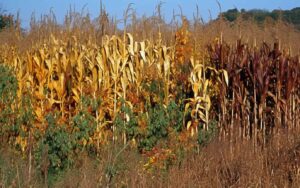Back to: Pre Vocational Studies Primary 5
Welcome to class!
Hello, my diligent student! It’s great to have you back for another important lesson. Today, we’re going to focus specifically on the “effects of weeds on farmers.” We’ve talked about what weeds are and how they compete with crops, but now we’ll see exactly how they impact farmers and their livelihoods. Let’s get started!
Effects of Weeds to Farmers

Weeds, as we know, are unwanted plants that grow among crops. While they might seem like a small problem, they can have significant negative effects on farmers. These effects can be grouped into several categories:
- Reduced Crop Yields:
- Competition for Resources: This is the most significant effect. Weeds compete with crops for essential resources like sunlight, water, and nutrients from the soil. If weeds are allowed to grow freely, they can steal these resources from the crops, leading to reduced growth and lower yields. It’s like having uninvited guests at a party who eat all the food – there won’t be enough left for the invited guests.
- Reduced Photosynthesis: Weeds can block sunlight from reaching the crop plants, which reduces their ability to photosynthesize (the process by which plants make food). This also leads to reduced growth and lower yields.
- Lower Crop Quality:
- Contamination: Weeds can contaminate harvested crops, making them less appealing to buyers. For example, weed seeds can get mixed in with grain, or weed parts can get tangled in harvested fruits or vegetables.
- Reduced Nutritional Value: In some cases, weeds can even affect the nutritional value of crops by competing for essential nutrients in the soil.
- Increased Costs:
- Weed Control Costs: Farmers have to spend time, money, and effort on controlling weeds. This can include hiring labor for manual weeding, buying herbicides (chemicals that kill weeds), or investing in mechanical weeding equipment.
- Increased Harvesting Costs: Weeds can make harvesting more difficult and time-consuming, especially if manual harvesting is used. This can increase harvesting costs.
- Reduced Market Value: If crops are contaminated with weeds or are of lower quality due to weed competition, they may fetch a lower price in the market, reducing the farmer’s income.
- Other Problems:
- Harboring Pests and Diseases: Some weeds can act as hosts for pests and diseases that can also attack crops. This can lead to further crop losses.
- Difficult Harvesting: Dense weed growth can make it difficult to harvest crops, especially with mechanical harvesters.
- Allelopathic Effects: Some weeds release chemicals into the soil that can inhibit the growth of crops. This is called allelopathy.
Let’s use an example. Imagine a maize farmer who doesn’t control the weeds in their field. The weeds will compete with the maize plants for water and nutrients, resulting in smaller maize cobs and a lower yield. The weeds might also make it more difficult to harvest the maize. The farmer will have to spend extra time and money on trying to control the weeds, reducing their profit.
So, to summarize, weeds have many negative effects on farmers, including reducing crop yields and quality, increasing costs, and causing other problems like harboring pests and diseases.
Evaluation
- Can you explain two ways that weeds reduce crop yields?
- Can you explain how weeds increase costs for farmers?
Excellent! You’re doing a fantastic job! I’m so proud of your learning.
We have come to the end of today’s class.
In the next class, we shall be talking about the Control of weeds.
In case you require further assistance or have any questions, feel free to ask in the comment section below, and trust us to respond as soon as possible. See you in the next class!
